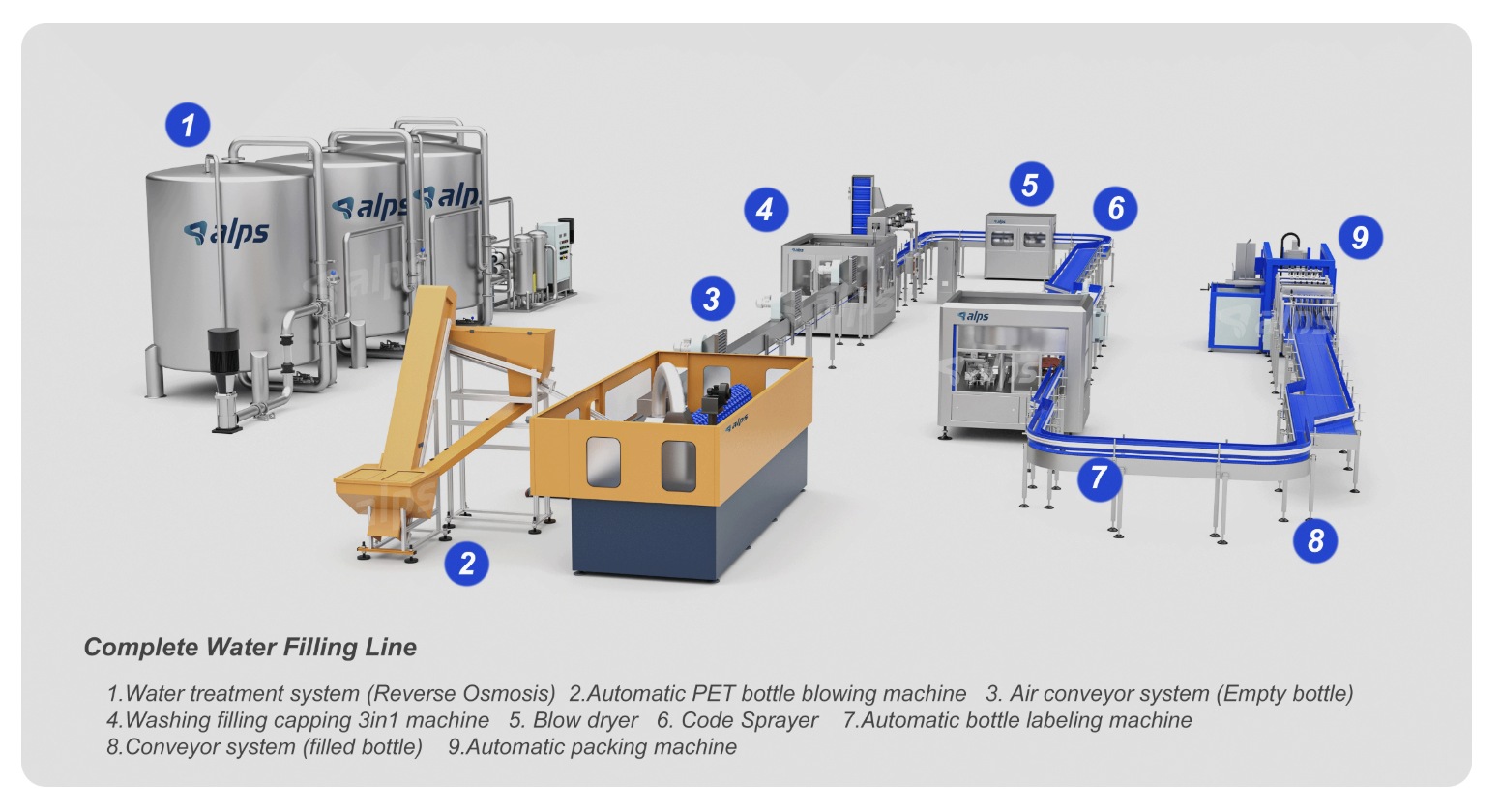Advanced Liquid Package Solution
In the bottled water and beverage industry, operational efficiency and product hygiene are crucial to staying competitive. As consumer demand grows and regulatory standards tighten, manufacturers are constantly looking for advanced bottling solutions. Two primary systems dominate the landscape: the traditional bottling line and the modern blowing filling capping combiblock line. While both have their merits, understanding the core differences is essential for making the right investment.
This article offers a detailed comparison of the traditional bottling line versus the combiblock line, evaluating them across critical parameters such as efficiency, cost, space, and maintenance. Whether you are upgrading your current production facility or setting up a new one, this guide will help you determine which solution best fits your operational needs.

A traditional bottling line is a linear configuration of separate machines that handle different stages of bottle production and filling. Typically, it includes a stretch blow molding machine for forming PET bottles, a filling machine for dispensing water or beverages, and a capping machine for sealing the bottles. These machines are connected by conveyors and buffer systems to manage the flow of bottles from one station to the next.
Traditional bottling lines have been the industry standard for decades. They offer a degree of flexibility, allowing operators to switch out or upgrade individual components. However, they also involve complex logistics, more operator involvement, and a larger physical footprint. The multiple transfer points between machines can result in higher risks of contamination and bottle damage.
A blowing filling capping combiblock line integrates the three main processes of bottle production—blowing, filling, and capping—into a single, compact unit. This system eliminates the need for intermediate conveyors and buffer areas by combining all three stages within a single enclosed machine. The preforms are automatically blown into bottles, filled with the desired liquid, and capped—all within the same chamber.
This technology is a product of modern engineering that addresses the industry’s need for high-speed, hygienic, and space-efficient bottling solutions. Combiblock systems are typically controlled by advanced PLC systems, offering automated operation, real-time monitoring, and minimal manual intervention. They are particularly well-suited for high-volume production environments where consistency and contamination control are critical.

Traditional bottling lines require significantly more space due to their segmented nature. Each machine occupies its own area, and the conveyors connecting them further increase the layout’s complexity. This often necessitates larger production facilities and careful planning to ensure smooth logistics.
In contrast, a combiblock line drastically reduces the footprint by combining three machines into one compact unit. This space-saving design is ideal for manufacturers operating in space-constrained environments or looking to maximize the utility of their existing floor space.
Traditional systems involve multiple transfer points, which can create bottlenecks and increase downtime during product changeovers or maintenance. Bottle jams, synchronization issues, and accumulation at transfer conveyors are common challenges.
Combiblock lines offer streamlined production with fewer stops and transitions. The integrated design minimizes handling and reduces cycle time, allowing for higher throughput. Additionally, changeovers are faster and more efficient, making them suitable for continuous, high-speed operations.
Every transfer point in a traditional line represents a potential risk for contamination. Open environments between machines expose the product to air, dust, and human contact, which can compromise the hygiene of the bottled product.
Combiblock systems are fully enclosed, ensuring that the product remains in a controlled environment from the moment the preform is introduced until the bottle is capped. This closed-loop system significantly reduces the risk of contamination, meeting the highest standards for food and beverage safety.
Traditional lines require separate power sources for each machine and additional energy for operating conveyor belts and buffer zones. This distributed energy requirement often results in higher operational costs.
Combiblock lines are engineered for energy efficiency. By consolidating functions and sharing drive systems, they consume less energy. Many models also incorporate energy recovery systems, further reducing power consumption and operating costs.
Traditional systems offer flexibility in maintenance, as individual machines can be serviced independently. However, they also require more frequent maintenance due to the greater number of mechanical components and synchronization elements. Troubleshooting can be time-consuming, especially when problems arise at transfer points.
Combiblock lines simplify maintenance by centralizing control and reducing the number of moving parts. Predictive maintenance features and integrated diagnostics help identify issues before they cause downtime. However, repairs may require specialized knowledge or support from the manufacturer, which can be a consideration for some operators.
Initial investment is typically lower for traditional bottling lines, especially for small to mid-scale operations. The modularity allows businesses to scale up gradually, adding equipment as demand grows.
Combiblock systems involve a higher upfront cost due to their integrated technology and automation. However, the long-term savings in labor, energy, maintenance, and space can yield a favorable return on investment (ROI), particularly for large-scale or rapidly growing operations.
Choosing between a traditional bottling line and a combiblock system depends on your specific operational goals, budget, and facility constraints.
Combiblock Systems Are Ideal For:
High-speed, high-volume production
Operations with limited floor space
Businesses prioritizing hygiene and product safety
Facilities with skilled technical staff or access to OEM support
Traditional Bottling Lines Are Better Suited For:
Small to medium production volumes
Businesses with limited initial capital
Operations requiring high flexibility in equipment selection
Environments where space is not a limiting factor
Careful evaluation of your production needs, expected growth, and regulatory requirements will help you make an informed decision.
Both traditional bottling lines and blowing filling capping combiblock systems have distinct advantages. The traditional approach offers flexibility and lower initial costs, making it suitable for businesses just entering the market. On the other hand, combiblock systems provide unmatched efficiency, cleanliness, and long-term cost savings, particularly beneficial for large-scale or premium bottled water production.
Ultimately, the best choice depends on your production scale, budget, space availability, and commitment to operational excellence. Consulting with reputable equipment manufacturers can provide tailored recommendations to align with your specific business goals.

By continuing to use the site you agree to our privacy policy Terms and Conditions.